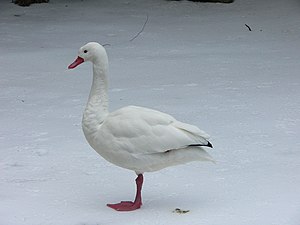Coscorobaschwan
| Coscorobaschwan | ||||||||||
|---|---|---|---|---|---|---|---|---|---|---|

Coscoroba Swan ( Coscoroba coscoroba ) |
||||||||||
| Systematics | ||||||||||
|
||||||||||
| Scientific name of the genus | ||||||||||
| Coscoroba | ||||||||||
| Reichenbach , 1852 | ||||||||||
| Scientific name of the species | ||||||||||
| Coscoroba coscoroba | ||||||||||
| ( Molina , 1782) |
The Coscoroba swan ( Coscoroba coscoroba ) is the only one of the duck birds known as swans to belong to its own genus . Like all swans, it is systematically classified in the family of ducks (Anatidae), but whether the other swans (of the genus Cygnus ) are its sister group is disputed. It occurs exclusively in South America. Coscoroba swans can live up to 20 years.
Appearance
The plumage is pure white in both sexes, the beak on the other hand bright red. Females are slightly smaller than males in direct comparison. The most noticeable distinguishing feature of the sexes is the color of the iris. Males have an orange-yellow to light cream-colored iris, while that of the females is more brownish. Due to the very short neck for a swan and the relatively long legs, it looks very much like a goose. As the smallest species of swan, the animals are about one meter long, with the male being larger than the female. Males weigh between 3.8 and 5.4 kilograms. Females weigh between 3.2 and 4.5 kilograms.
In the youth dress the small plumage is predominantly white. The head parts to under the eyes as well as the back and the wings are gray-brown feathered. The bill and legs are dark gray. They only lighten reddish with increasing age. In the first annual dress, the small plumage of the not yet sexually mature swans is white. The beak, the iris and the legs are also colored as in the adult birds. Only the wings of the hand and the wing covers are gray.
distribution and habitat
Coscoroba swans live in wetlands, especially reed-covered lakes and swamps in South America , from southern Brazil to Tierra del Fuego . In 2000/2001, a breeding pair successfully raised offspring on the Falkland Islands for the first time since 1860 . These birds overwinter in Chile and northeast Argentina after they have moulted in the breeding area.
Way of life
Coscorobas swans live on grass and small water plants, but also on mussels , oysters and small fish .
Once mated, males and females stay together for life. The female lays about seven eggs and incubates them alone for about a month. However, the male helps with the rearing of the young birds, which quickly become independent. They are aggressively defended against possible predators such as birds of prey .
Danger
According to various estimates, there are still around 10,000 to 30,000 birds today.
Individual evidence and further information
literature
- Janet Kear (Ed.): Ducks, Geese and Swans. Oxford University Press, 2005, ISBN 0-19-854645-9 .
- Josep del Hoyo et al .: Handbook of the Birds of the World. Volume 1: Ostrich to Ducks. Lynx Edicions, 1992, ISBN 84-87334-10-5 .
- Hartmut Kolbe: The world's ducks. Ulmer Verlag 1999, ISBN 3-8001-7442-1 .
- Hadoram Shirihai: A Complete Guide to Antarctic Wildlife - The Birds and Marine Mammals of the Antarctic Continent and Southern Ocean. Alula Press, Degerby 2002, ISBN 951-98947-0-5 .
Web links
- Coscoroba coscoroba in the endangered Red List species the IUCN 2008. Posted by: BirdLife International, 2008. Accessed on December 21 of 2008.
- Videos, photos and sound recordings about Coscoroba coscoroba in the Internet Bird Collection
